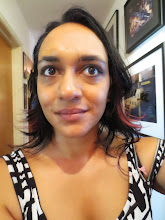To begin with, the show's curators Henry Thaggert and Jeffry Cudlin cite the influence of Kara Walker as a crucial impetus for this show, which was prompted by Walker's mid-career retrospective at the Whitney Museum earlier this year. Walker, they propose, has a lock on the discourse surrounding black female experience and creative output in the contemporary art mainstream. Her work hinges on caricature and the grotesque, and for this reason it is a palatable discussion of race within an art market unwilling to engage more nuanced or positive images of blackness. They cite as precedent the very public critique of Walker lodged by Betye Saar nearly a decade ago, calling the younger artist out for perpetuating rather than challenging racist assumptions held by the larger public. A cogent point of view -- but is it true today?

Kara Walker: My Complement, My Enemy, My Oppressor, My Love, installation view, 2007 (Photo: Sheldon Collins)
In 1997 when she became the youngest artist ever to win the MacArthur Fellowship, Kara Walker was a lone black woman in a predominantly white and male art market. Though the dominant paradigm has yet to be smashed, today Walker is not the only African-American female artist to succeed in the commercial art world. Wangechi Mutu, Renee Green, Mickalene Thomas and Shinique Smith are a few of the African-American women leading in the arts these days. Black curators like Okwui Enwezor, Franklin Sirmans and Thelma Golden have tremendous influence, and are able to introduce young black talent at a very high threshhold of exposure. To be sure, there is a long way yet to go, but the argument that Walker's voice alone is heard seems outdated in light of these facts.

Wangechi Mutu, Magnificent Monkey-Ass Lies, 2004
Furthermore, is the best way to increase the prominence of black women in the art world to create a show that puts a group together based solely on the fact that all are black women? Many artists today would be reluctant to participate in such a project, and those who did would likely insist that their ambivalence about that grouping be made known. When Taraneh Hemami and I curated East of the West this past spring, we met a lot of resistance to the premise that artists of Middle Eastern origin should show together. Only by framing the exhibition in other terms -- with respect to the politics of image, media critique and the immigrant experience -- were we able to assuage their concerns. She's So Articulate touches on contemporary issues, but ultimately it feels dated by a one-size-fits-all identity politics approach.
This is especially jarring because the artists in the show don't seem very interested in identity politics. The exceptions are Ringgold and Renee Cox, both of whose included works are already ten years old. Most of the work, if about race and gender at all, is about the subtleties of identity and the difficulty of pinning down a right or wrong approach. I am thinking of lauren woods, Erika Ranee, Renee Stout, Nadine Robinson and Stephanie Dinkins. Other work seems to be only indirectly about race -- Torkwase Dyson, Nekisha Durrett and Djakarta seem to have other things on the forefront of their minds.
Beyond this, shows that group by category risk further marginalizing rather than promoting the artists included. Only viewers who are already interested in black female perspectives will see such a show, while the inclusion of African artists in major contemporary art surveys such as Documenta 12 and the 2007 Venice Biennale or of African-American artists in the National Portrait Gallery show Recognize exposed those artists to a mixed audience who might otherwise not have sought them out.
Since I am interested in these points of view, I enjoyed She's So Articulate and welcomed the chance to learn about artists with whose work I was not yet familiar. I enjoyed the debate this exhibition prompted, and hope for it to continue. The exhibition design and installation were strong, the work looked good, and the text was well-written and low on obfuscating artspeak. However, an exhibition framed as a critique of another artist's work is challenged by its very premise, and in this case that context detracts from rather than enhances perceptions of the work included.
I welcome further discussion in the comments!



